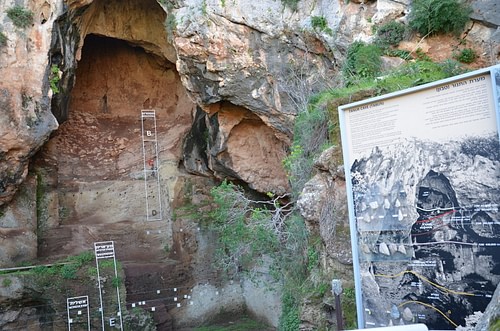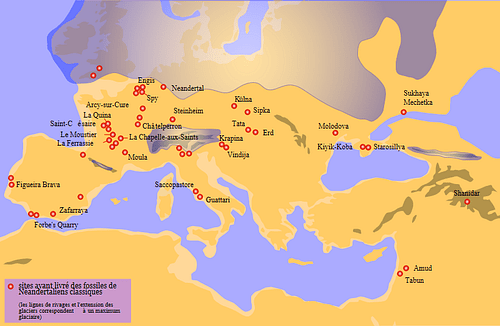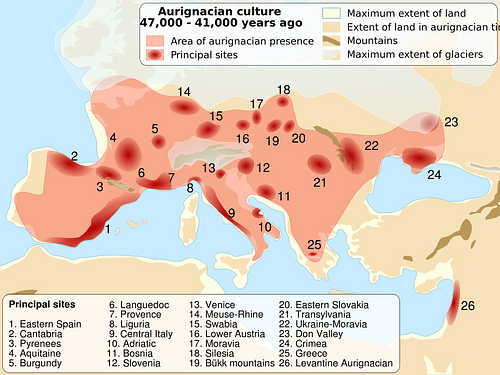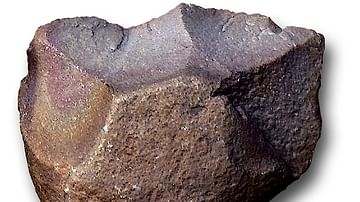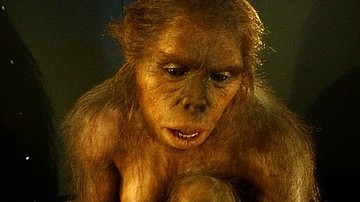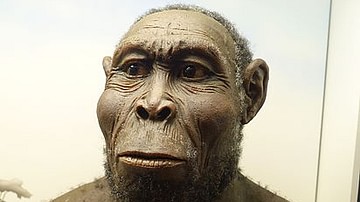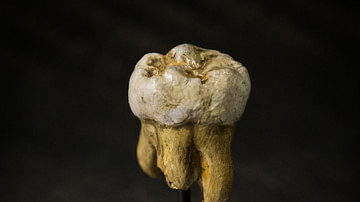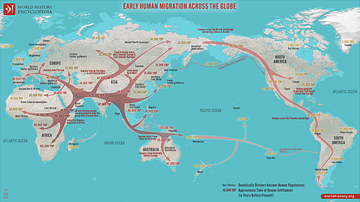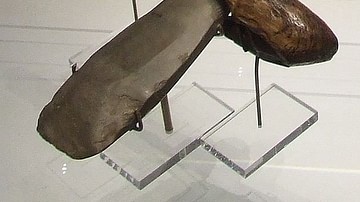In May 2010, after years of intense discussions surrounding possible fossils of mixed Homo sapiens and Neanderthal descent floating around the scientific community, a team led by Svante Pääbo of the Max-Planck Institute for Evolutionary Anthropology in Leipzig, Germany, published the results of their pioneering journey towards retrieving ancient Neanderthal DNA. The study sent out a shock wave: it discovered that our own DNA contains between 1-4% Neanderthal DNA, meaning our early modern human ancestors had indeed not only shaken hands with Neanderthals back in Ice Age Eurasia, but had also definitely shaken other body parts and interbred with them. The team's find not only pushed modern humans and the Neanderthals a lot closer together, but also paved the way for more ancient genetic research, which has since been shedding more light on the Neanderthal-Sapiens connection.
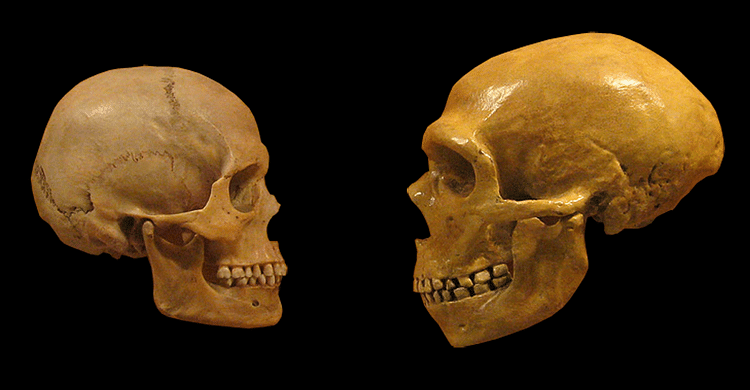
The Neanderthals were relatively short and stocky humans with big brains who gradually developed in chilly Eurasia, with features that become clearly recognisable between c. 200,000-c. 100,000 years ago and the 'classic', full set of features as we identify them settling in around 70,000 years ago. They were well-adapted to the often cold temperatures that held sway across the regions they were found in, all the way from Spain and the Mediterranean to Northern Europe and Russia, as well as throughout the Near East, and as far east as Uzbekistan and Siberia, and were capable of hunting even the biggest Ice Age creatures such as mammoths or woolly rhinoceros.
Genetic research has shown that the Neanderthals are a sister group to us; we share a common ancestor quite a long way back, in Africa, between c. 550,000 and c. 750,000 years ago, but our relation with them does not end there. Although already meeting and interbreeding with their sister species in more localised instances as far back as 100,000 years ago, possibly in the Near East, modern humans first expanded into Neanderthal territory at large from around 55,000 years ago, when a big wave of them left Africa and started spreading across the world, with the Near East as a first pit-stop. It is this location and timeframe that accounts for the biggest visible chunk of Neanderthal DNA entering our modern human systems. On their travels into the rest of Eurasia, modern humans clearly did not find vast, uninhabited lands with unchallenged prey for them to hunt, but had to share or compete. Somehow, after successfully surviving for such a long time in not exactly the breeziest of conditions, Neanderthals then disappeared from the fossil record by around 40,000-30,000 years ago, not long after modern humans encroached on their grounds.
There are still a fair few hiccups in our knowledge of what happened when these two species met. For instance, it is hard to say how we should visualise them actually meeting and sharing certain areas; the options range from excessively violent and competitive to happily exchanging tips and tricks. It is also not entirely clear whether or not Homo sapiens may have had a direct or indirect hand in pushing the Neanderthals into extinction, and which other factors may have been at play.
Another big component to this debate is interbreeding – how exactly does it fit into this story? Under which circumstances and to what extent this may have taken place can radically alter the view we have of how modern humans and Neanderthals interacted over the space of time they shared Eurasia. It certainly impacts on our view of the social side of things; it means that genes were exchanged and our genetic makeup was altered, an effect that was felt not just there and then in Ice Age Eurasia but all the way up until this day. It also means Neanderthals did not die out in the strictest of senses, because part of their DNA still survives in us.
Initial meetings
As mentioned above, there is a family relation; by at least c. 500,000 ago one group of what is generally thought to have been Homo heidelbergensis (or Homo antecessor) upped and left Africa, journeyed all the way to Europe and somewhere in those regions gradually developed into Neanderthals, while the portion of Homo heidelbergensis that was quite alright with Africa and stayed behind became part of the eventual development towards Homo sapiens (who appeared by around 200,000 years ago).
By the time these two sister groups would meet in person, there were some differences. Neanderthals had stockier builds and big skulls with brow ridges, lacking a proper chin, and modern humans had tall, slender skeletons and heads with chiselled chins and faces tucked in under our braincases. However, both hunted and gathered, used well-crafted tools to survive, and show evidence of things like fire usage and burials.
Both genetic evidence and archaeological finds seem to support the Near East as the place of first contact. This area shows (so far) the earliest evidence of Homo sapiens outside of Africa, at the sites of Skhul and Qafzeh in Israel, where burials have been dated to be older than 100,000 years ago – and perhaps even up to a staggering 130,000 years ago. Moreover, Neanderthals are also known to have been present here, at neighbouring sites such as Tabun Cave and Kebara Cave. Evolutionary geneticist Svante Pääbo envisions a possible scenario where modern humans may have moved into these Near Eastern caves when the climate was warmer and more suited to their needs, whereas Neanderthals could have been pushed that far south in colder periods, likely resulting in these two species meeting at least at some point within the long period of time they weaved in and out of the same region. This Near Eastern setting is also the most logical explanation for the very early presence of Homo sapiens DNA in a set of Neanderthals found in the Altai Mountains in Siberia – a place where Neanderthals are also known to have interbred with another human species, the Denisovans – as the data indicates that ancestors of these Neanderthals must have met and interbred with modern humans around 100,000 years ago.
The main interbreeding events we can trace today
However, the main component of Neanderthal DNA that jumped over into our Sapiens gene pools came from interbreeding at a later point in time; as the main wave of modern humans left Africa around 55,000 years ago, they seem to have run into the Neanderthals in the Near East and mixed with them (or, perhaps, mixed with a crowd of modern humans living there who had themselves already interbred with Neanderthals at some point in the past). This group of travelling Sapiens then carried their mixed genes to the far reaches of the world as they spread out across Asia (with East Asians possibly receiving another shot of Neanderthal DNA along the way) and into Europe. As a result, non-Africans today possess on average around ~2% Neanderthal DNA. Interestingly, somewhere in Southeast Asia these modern humans bumped into yet another species of human that was already presumably living there – the Denisovans. This gives us another clue about what was likely to happen when two different groups of humans met; modern humans interbred with them, too, between c. 54,000-c. 44,000 years ago. When it works, it works; there are plenty of clues that interbreeding was likely a common feature along our evolutionary road.
When it comes to the practical side of these kinds of mixings, we do not know whether we should picture meetings between two different – albeit related – kinds of humans as spontaneous neighbourhood barbecues that resulted in people getting quite friendly with each other as more food and drink was consumed, as violent and unhappy affairs, or anything in between. What we do know is that – as far as we can detect, that is – all or almost all of the genes that jumped over flowed from Neanderthals into modern humans, meaning there were mixed babies that were raised in modern human societies. However, this does not mean the reverse did not happen, too; possible fertility issues in that direction, or the fact that such gene flow would not have been preserved as easily in the smaller and already shrinking Neanderthal population, may have simply made it untraceable for us today.
Sharing Eurasia
Upon arriving in Europe by at the earliest around 45,000 years ago in a single founding population, Homo sapiens may have had a bit of an 'Ah, you guys again' revelation (not literally, of course, as there would have been a few thousand years in between the Near Eastern encounter and the European ones). Right off the bat, there was a huge contrast: Neanderthals had been living in temperamental Ice Age Europe for thousands of years already and had adapted to the cold both physically and with regard to their lifestyle, whereas the arriving modern humans, albeit already carrying bits of Neanderthal DNA with them, would have had to learn to cope with the new regional conditions. Although it seems like this might have put Sapiens at a disadvantage when trying to carve out their own living space, they were hugely helped by the fact that the numbers were in their favour; both their group sizes and their overall population density were much larger than the resident Neanderthals, whose already dwindling population must suddenly have faced competition for resources.
But how did this Europe-sharing work in practice? Whether or not the invading modern humans ended up sharing certain valleys and actively socialising and exchanging tips and tricks with the resident Neanderthals, or whether they instead pushed the Neanderthals out of their way and covered the previously Neanderthal sites with their own tools and objects is a question with more than just one possible answer. When a certain site shows an earlier, distinctly Neanderthal tool culture (a big general one around this point in time is the Mousterian), and a slightly later Homo sapiens-made tool culture (the main one associated with Sapiens spreading across Europe is the Aurignacian), with no evidence that either set of tools had clearly influenced the other – which would imply acculturation – we tend to lean towards the displacement idea. This can arguably be seen at, for instance, Kaldar Cave in Iran, sites in the Swabian Jura in Germany, some sites in Italy, and at Châtelperron in France.
However, some other sites paint a different picture. The Middle Danube region in Central Europe, for instance, shows the influence of a newly arriving stone tool culture on an already existing Neanderthal one, and suggests that these two specific groups would have literally stood eye to eye to some degree and overlapped a bit in living space. Close proximity, although visible here, may not even have been a prerequisite for a certain degree of influence, though; ideas were possibly even capable of spreading indirectly across much larger distances. Theoretically, if a Neanderthal in the Lower Danube region came really up close and personal to a modern human there and was shown a nifty new tool, this knowledge could have spread when his group met another Neanderthal group, and so forth, travelling all the way to a Neanderthal group in the Dordogne in France.
There is actually a really cool find that shows how fluid this whole connection story must have been in practice. It is now clear that a bone tool known as a lissoir, which was thought to have been exclusively modern human, was already created from within a Neanderthal context before Sapiens even arrived in Eurasia. This means that this tool was either invented independently by the Neanderthals; that they were somehow influenced by Sapiens across large distances; or that modern humans actually hijacked the idea for this tool from the Neanderthals in the first place.
Considering the varied nature of our own species, I feel it is safe to say we should imagine a broad range of different scenarios for when Neanderthals met modern humans and vice versa. Some of us (and them) would undoubtedly have been violent brutes taking over areas that caught their eye, whereas others would have been more curious and social, obviously up to a close enough point to interbreed on certain occasions, which probably continued at least to an incidental degree after the 'main' traceable mixings in the Near East. The two groups certainly had a couple of thousand of years of overlap during which they could potentially have exchanged both ideas and genes, as well as competed for resources. Going a step further, though, there is even a fairly widespread belief that modern humans were cognitively and technologically superior, giving the Neanderthals a run for their money.
The Neanderthals' disappearance
This superiority argument has been fairly popular in the past. The idea is that modern humans were smarter and better than our competitors – using superior weapons and more effective hunting strategies – to which the Neanderthals had no sufficient answer. As a result, they then eventually kicked the bucket.
Up until the last decade, this theory was backed quite well by the archaeological evidence. Whereas Upper Palaeolithic modern humans were clearly capable of making stuff like spear throwers and created beautiful cave paintings that must surely show they had developed to the point of symbolic thought, it was hard to prove the Neanderthals came up to the same cognitive benchmark. However, more recent studies have pointed out there really was not enough of a difference between these two humans to make this supposed superiority the main perpetrating factor. Neanderthals are now known to have been highly sophisticated, too; they used ochre in a likely symbolic way, knew sophisticated heating techniques to produce pitch, and produced ornaments such as eagle claws as well as quite specialised tools (including the bone lissoirs named above). Moreover, they were formidable large game hunters with a broad general diet who must have really known their way around prehistoric Eurasia.
The supposed gap between our species is narrowing. Clearly, we were not so very different at all, and certainly not different enough for it to have been the only cause of the Neanderthals' extinction. Earlier this year, a study even suggested that because there was such a difference in population size between the two groups, modern humans would not have needed any severe advantage over the Neanderthals in order to replace them. Not only were there a lot fewer Neanderthals, living more scattered and in smaller groups than the arriving aliens; their numbers, too, were already decreasing when modern humans entered the arena, leaving them vulnerable.
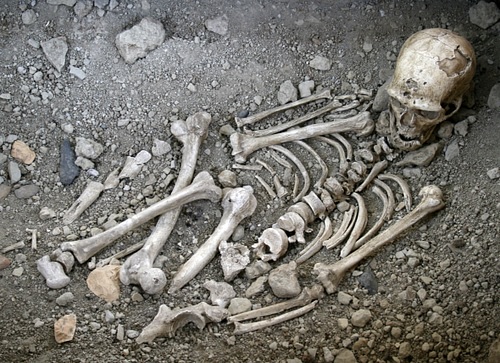
Something that may have had a hand in this and that has previously been overlooked a bit is the climate, which is now known to have been much more unstable around that time than we thought. On the Iberian peninsula, for instance, evidence has popped up indicating that Neanderthals vanished from there as early as around 42,000 years ago (while in other regions in Europe they may have clung on until c. 30,000 years ago at the latest), and that right at this time the climate started going through all sorts of annoyingly large fluctuations. This could help explain their dwindling population size in general.
Interestingly, there are also theories that point at interbreeding as a contributing factor to the Neanderthals' demise. Although we know that interbreeding happened, probably in the Near East, it is hard to reconstruct how common this may have been throughout the period in which Neanderthals and modern humans came into contact with each other. The huge amount of time that has passed since the Neanderthals disappeared would have watered down their genetic contribution, and there is evidence that the mixings were never even a straight-forward affair, but came with selection against certain portions of Neanderthal DNA. Male mixed children may have been sterile, which would obviously reduce the amount of Neanderthal DNA being passed on beyond that first step. The social dynamics between the two groups must have played a role, too. All in all, it is possible that mixing might have happened fairly consistently, and that the dwindling Neanderthal population may have been partially assimilated into that of the modern human newcomers. One can imagine the much larger modern human numbers effectively 'swamping' the Neanderthals, but it is hard to say how likely a scenario this is.
What is clear is that the Neanderthals vanishing from the fossil record (but not the genetic one) must have been the result of a complex process involving many different factors, such as tough climatic conditions; a small and dwindling population size; contact with newcomers that at least in some areas included interbreeding; probably competition for resources; and perhaps even assimilation.
The genetic impact
Our colliding fates actually go to a deeper level still. Science has reached that wonderful point where we can see not just the DNA we originally received from the Neanderthals, but also unearth the functions of some of these genes which still have an effect on us today. Among the ones that have been identified are genes affecting skin and hair colour, which suggest that as modern humans first arrived in the colder Eurasian conditions, they helped themselves adapt by picking up lighter skin and fairer hair from the Neanderthals. The immune system shows a similar story; certain variants of genes boosting immune response, which would have helped defend modern humans against the new array of parasites and bacteria, are courtesy of both Neanderthals and the Denisovans.
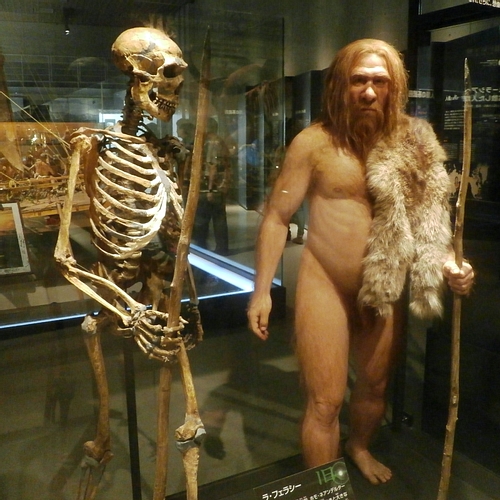
However, although these changes were probably originally useful within hunter-gatherer societies trundling around the prehistoric landscape, our vastly different lifestyles and environments today mean that we are now seeing some serious side-effects of the Neanderthal legacy. For instance, although a gene variant that ensures faster blood clotting could have saved the lives of prehistoric people getting hurt running around hunting things that were a fair bit bigger than they were, it also increases the risk of strokes and the likes, which is inconvenient considering today's high life expectancy. Moreover, in today's more sterile environments, the Neanderthal immune response boost sometimes gets translated into allergies. Other present-day issues that seem to have roots within the transmitted Neanderthal DNA in modern humans are all sorts of fun things like urinary tract disorders, nicotine addiction, skin lesions, risk of depression, predisposition towards malnutrition, and, for Native Americans, increased risk for type 2 diabetes. Clearly, we really thought this one through when we met our first Neanderthal.
The Denisovan genome has been sequenced, too, so their genetic impact on us is also starting to be canvassed. It has become clear, though, that it was not just these two species of human Homo sapiens got all up close and personal with, but that different humans mixed all the time, even way back within Africa. Palaeontologist John Hawks compares our evolutionary path to a river delta, with a main stream that supplied more than 90% of the ancestry of today's humans, and loads of other little streams weaving in and out, eventually heading into the desert and going extinct. We even know that some still unknown human 'ghost' lineages must have existed because of this genetic legacy. Homo sapiens are the product of this entire past and preserve a dynamic and varied history of many meetings, in which the Neanderthals clearly played an interesting part, but there is no doubt that we also played an interesting part in the lives of all of these other humans, too.

